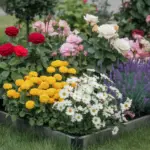7. Urban Flower Meadow: Creating a Wild Paradise in Small Spaces

Let me tell you about my journey creating an urban meadow in my tiny backyard! I remember standing there thinking, “How in the world am I going to turn this postage stamp of a space into something magical?” Well, after five years of trial and error, I’ve learned exactly how to create that dreamy wildflower look without letting it turn into a chaotic mess.
Choosing the Right Wildflowers
The secret to a successful urban meadow starts with smart plant selection. I learned this the hard way when I first planted some aggressive varieties that nearly took over my entire garden! Now I stick to well-behaved favorites like Black-Eyed Susans, Echinacea, and California Poppies. These beauties play nice with others and don’t try to stage a garden coup!
For small spaces, I’ve found that mixing low-growing flowers with medium-height bloomers creates the most natural look. About 60% of your meadow should be compact varieties under 24 inches tall. My go-to combination includes:
- Cornflowers for early season color
- Cosmos for summer-long blooms
- Mexican Fleabane for ground cover
- Native Yarrow for structure
- Baby’s Breath for airy texture
Creating Natural-Looking Patterns
Here’s a pro tip that took me ages to figure out: ditch the traditional rows completely! Instead, I use what I call the “scatter and clump” method. First, divide your space into rough thirds. Then broadcast smaller seeds in natural-looking drifts, and plant larger specimens in groups of 3-5 plants. This creates that gorgeous, seemingly random pattern that nature does so well.
Maintaining Your Mini Meadow
The beauty of an urban meadow is its relatively low-maintenance nature. I spend maybe an hour a month on actual maintenance, which is perfect for my busy schedule. The key is to:
- Water deeply but infrequently
- Allow beneficial insects to handle pest control
- Cut back only once at the end of winter
- Leave seed heads for winter interest and wildlife
- Avoid fertilizers – meadow flowers prefer lean soil
Planning for Year-Round Interest
One of my favorite aspects of meadow gardening is planning the bloom succession. I’ve structured my small meadow to provide continuous color from early spring through late fall. It starts with Woodland Phlox in spring, transitions to Coneflowers in summer, and finishes with Asters in autumn.
Supporting Local Wildlife
You wouldn’t believe the difference a small meadow makes to local biodiversity! My tiny space now hosts countless bees, butterflies, and even the occasional hummingbird. The secret is to include at least 70% native species in your planting mix. These plants have co-evolved with local wildlife and provide the best habitat support.
Ready to discover another amazing way to maximize your small garden space? Our next section explores the art of creating stunning Color-Themed Flower Borders that will make your neighbors stop and stare! Click the next button below to learn my favorite tips for coordinating colors like a pro and creating those Instagram-worthy garden moments that look effortless but pack a serious punch.









GIPHY App Key not set. Please check settings